The little Peacock Orchid is completely unfairly rarely grown both in indoor floriculture and in the garden. Despite its tiny size, the plant is incredibly spectacular and decorative. The only drawback of the flower is that the life of the Peacock Orchid is very short.
An elegant plant comes from the foothill regions of India and China, but today a wonderful baby in the wild is easy to meet in the north of Thailand and Laos, near the southern and southeastern outskirts of Burma, in the central regions of Nepal and Vietnam Orchids. Peacock Orchid grows at an altitude of 600 to 4200 m above sea level and prefers a cool climate.

For the first time, a tiny orchid was described by a British botanist David Don at the beginning of the 19th century. Among natural species and natural hybrids, most lead an epiphytic or terrestrial lifestyle, only a few plants prefer to settle on rocks.
The name of the genus was given to small orchids on behalf of the mythological mother of the Pleiades sisters. It is connected, most likely, with the property of the plant to form many daughter pseudobulbs near the flask-shaped parental tuberidium, which in some species acquires a purple-violet hue instead of dark green. There is also a Pleione star in the constellation Taurus, as well as a tiny plant named after the heroine of ancient Greek mythology. Types of orchids with pictures and names.
Botanical description of Peacock Orchid
In the spring, from the beak-shaped crown of each pseudobulb, reaching the size of a walnut in its mature state, as a rule, one or two elongated oval leaves are formed, which die off in the same way as the old maternal pseudobulb, with the advent of winter.
Peduncles are short, appear early in spring before foliage blooms, only in some species in autumn. Usually, 1-2 flower-bearing stems are formed from one pseudobulb, which carry one flower up to 6 cm in circumference, very rarely two. The petals are fanned out like a peacock’s tail. From their base, a tubular lip is inclined perpendicularly, all in patterns of speckles, dashes or wavy lines.
The color palette of natural species is limited to lilac-pink hues, and cultivated hybrids bred by breeders have a wider range of halftones – from snow-white and pale yellow to pink-raspberry, purple-lilac, coral.
Peacock Orchid Varieties and Types
Scientists have not come to a consensus on the number of species and natural hybrids: the British call 19, Italian experts – 22 species. According to The Plant List database, the Pleione genus in the Orchidaceae family includes 26 species. The most popular of them in cultivation:
Peacock formosana
Peacock formosana, or beautiful (P. formosana) is one of the most common species that has produced many very beautiful varieties with soft pink, white and pinkish-lilac petals and a light lip with brown spots. here is Pink Orchid Varieties.
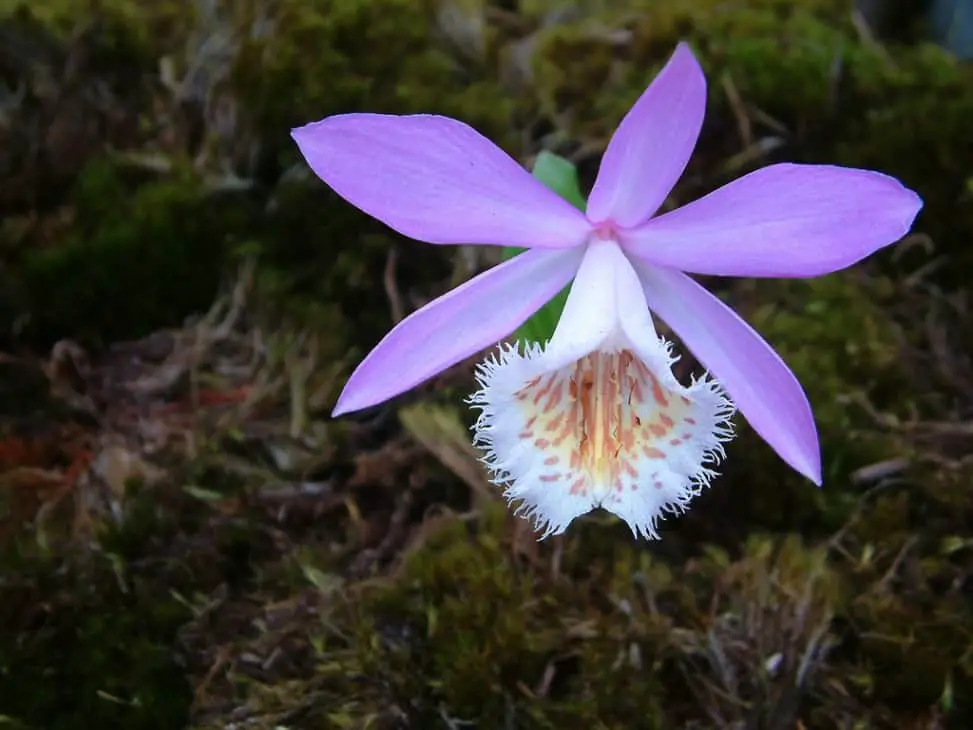
Pleione squat
Pleione squat (P. humilis) a miniature orchid with a flask-shaped olive-green pseudobulb. The flowers are snow-white, only small raspberry or yellow-chocolate spots are sprinkled on the lip.
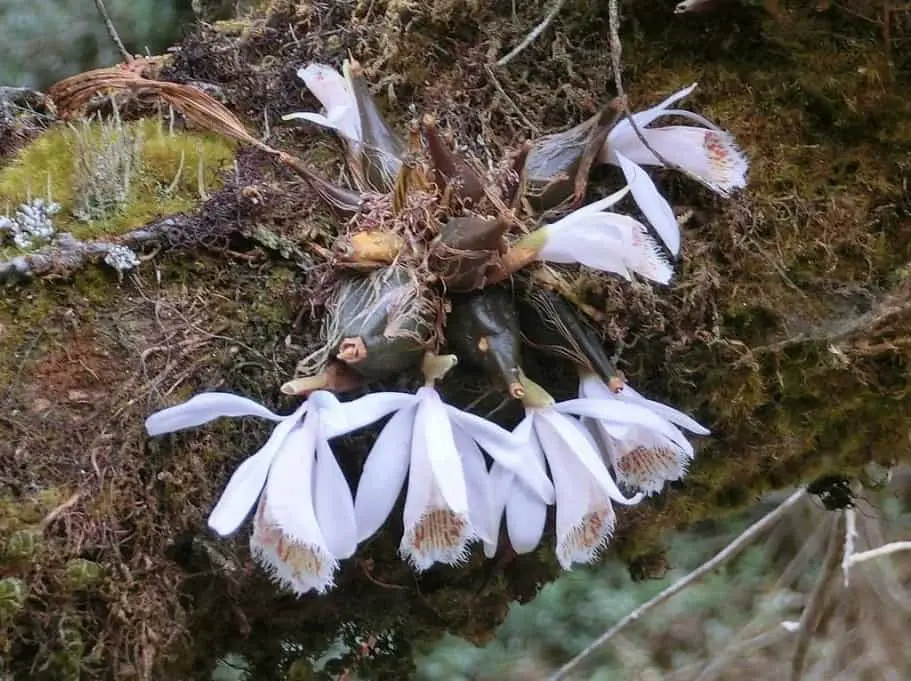
Peacock Shantung
Peacock Shantung (P. shantung) – an orchid variety with an unusual flower color for a Peacock lemon petals are either orange, and the lip is snow-white or yellow with bright scarlet marks.
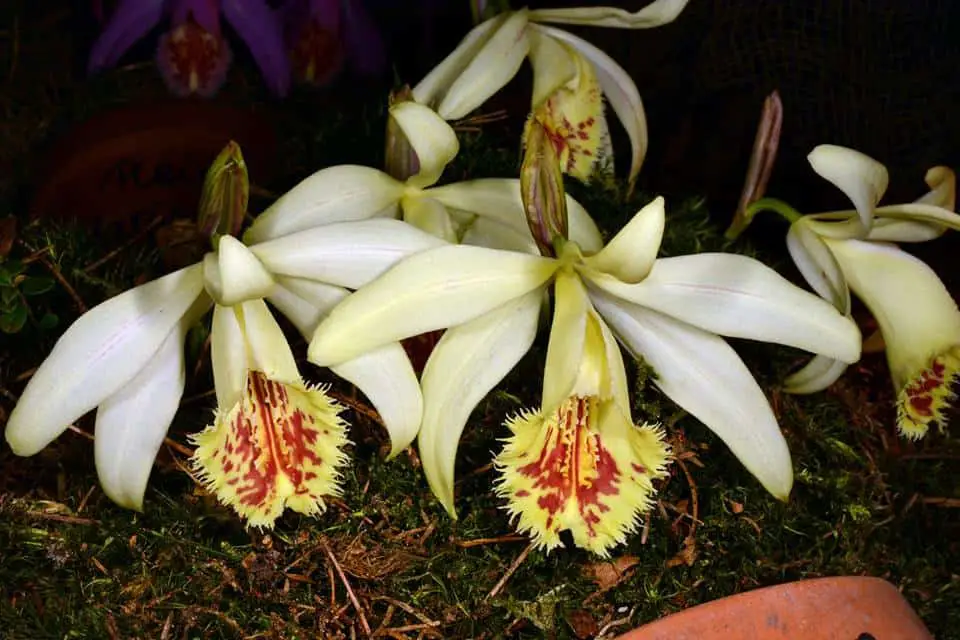
Peacock Versailles
Peacock Versailles (P. versailles) – one of the old hybrids with mauve flowers, the lip of which is covered with a pattern of bright red specks and strokes.
Peacock Tongariro (P. Tongariro) – a variety with delicate purple petals and a white background of the inner color of the tubular lip, along which small dark purple spots are evenly strewn.
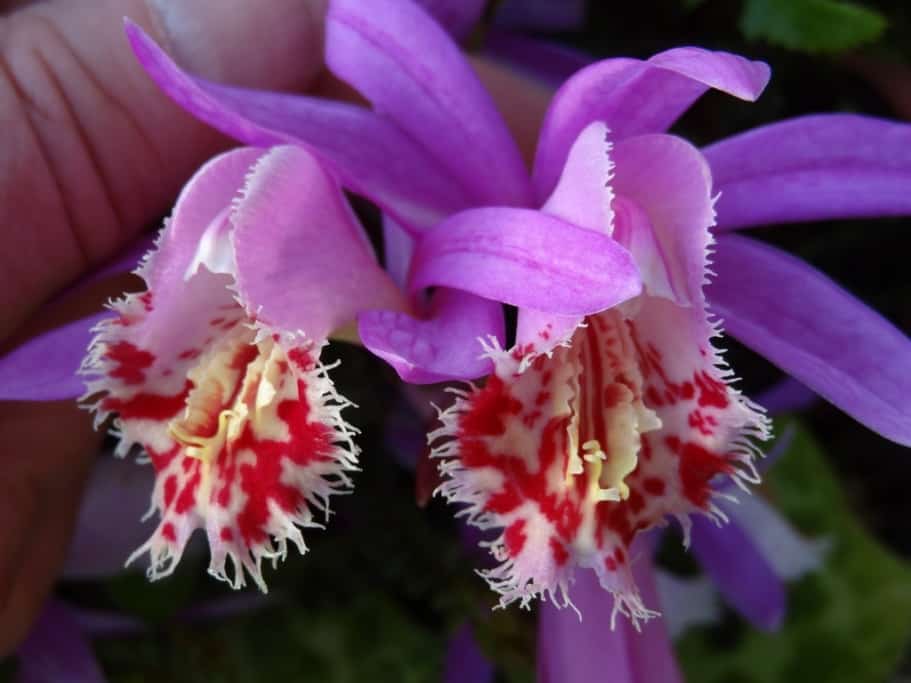
Peacock Hooker
Peacock Hooker (P. hookeriana) – pear-shaped pseudobulb, with two oval leaves and small white flowers about 5 cm in circumference. The lip is long, tubular, with a yellow-brown pattern closer to the edge. Blooms late compared to other species in May – June.
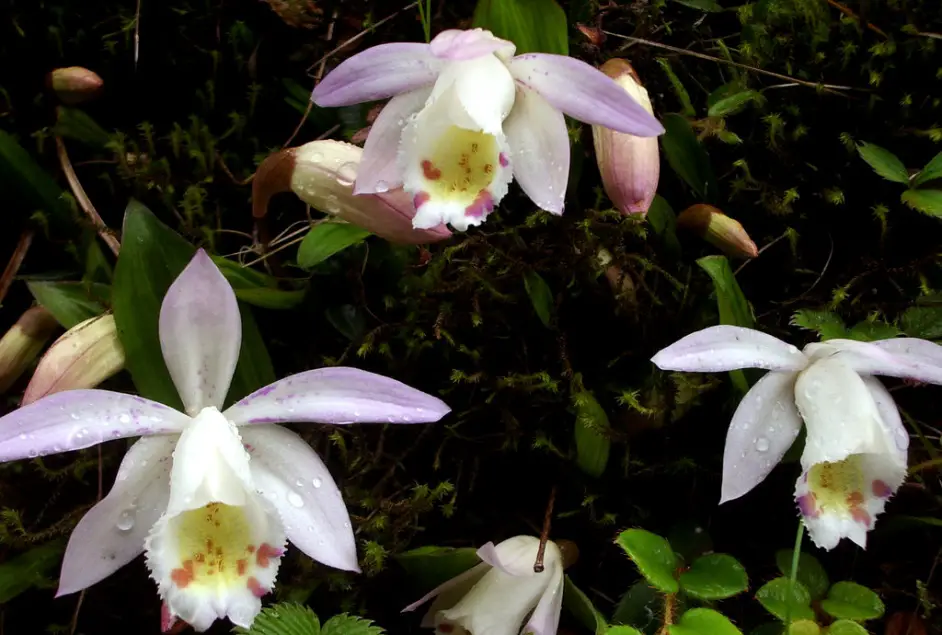
Peacock Bulbokodia
Peacock Bulbokodia (P. bulbocodioides) is one of the garden species that is resistant to cold winters and suitable for outdoor cultivation. The flowers are large, white-pink, the lip is large, with fringed edges and a purple-red pattern.
Peacock Orchid Growing conditions indoors and in garden
Peacock is a cool orchid. She does not like the bright sun, therefore, both in the house and in the garden, she is placed where it is possible to protect the plant from direct sunlight. Indoors, shaded eastern, northern or western windows are suitable for her, and on the site she is planted in the scattered shade of deciduous trees.
In summer, temperatures above 26 degrees Celsius are harmful to the Peacock; in the off-season, the orchid prefers a microclimate with thermometer readings from 8 to 18 degrees above zero. In winter, a dormant period begins for the plant, its roots and leaves die off, and the pseudobulbs are stored at a temperature of 1 to 4 degrees Celsius in the refrigerator, taken out of the substrate, or in a dry, frost-free basement in pots. They are regularly monitored so that they do not dry out or rot from dampness. In open ground, the plant hibernates only in regions where the air temperature does not drop below zero degrees in winter.
How to plant Peacock Orchid in pot and in flower bed
The orchid is transplanted every spring, regardless of which pseudobulb storage method is chosen. If the plant is taken out of the substrate in autumn, it is carefully examined for rot-damaged areas on the pseudobulbs.
An orchid wintering in a pot of soil is removed from the container and the children are separated, which form in clusters near the mother plant during the growing season. Old dead pseudobulbs older than 2 years are no longer subject to planting, they are disposed of.
The plant is planted in pots in late January or early February. The container is preferably clay or ceramic. A low bowl of small diameter is chosen and several pseudobulbs are planted in it, deepening them by 2/3 into the soil mixture.
The substrate for the Peacock Orchid is as air and water permeable as possible, and a drainage layer is necessarily laid at the bottom of the pot.
Possible soil mixture options for orchids:
- sphagnum – 1 part, pine bark – 2 parts;
- fine-grained pine bark – 4 volumes, vermiculite, charcoal, peat – 1 volume each, foam plastic crushed to 3–6 mm – 2 volumes;
- perlite – 1 part, pine bark – 2 parts, sphagnum – 3 parts.
In the garden, Peacock Orchid pseudobulbs are planted in groups at a distance of 10-15 cm from each other. The place is chosen not flooded, with loose soil. Planting time depends on the climate of the area, as a rule, they are planted when nighttime temperatures are above 8 degrees Celsius.
Peacock Orchid care at home
During the growing season, the plant requires constant soil moisture and increased air humidity up to 60%, therefore it responds gratefully to timely watering, which does not allow cardinal drying of the soil mixture, and regular spraying.
Both in the garden and indoors, the grown Peacock Orchid is watered with soft settled water at room temperature. The last regular watering is done at the end of September, then watering is stopped and the plant is allowed to prepare for dormancy. Usually at this time the foliage of the orchid begins to turn yellow and die. In November, pseudobulbs are already dug out of the ground and sent for storage.
Top dressing is carried out during the growing season from May to October once a week with special complex fertilizers for orchids. Stop feeding with the first signs of yellowing of the leaves.
Peacock Orchid Propagation methods
At home, the orchid is propagated only with the help of daughter pseudobulbs. In autumn, when the plant has prepared for dormancy, old tuberidia are dug out of the soil. A lot of small pseudobulbs usually form around them. The roots are almost dead by this time, so the newly formed tuberidia are carefully separated from the mother bulb and stored together with adult pseudobulbs in the refrigerator in the vegetable compartment.
If plants in pots are moved to a basement that does not freeze in winter until spring, reproduction of the Peacock Orchid is carried out at the end of January or at the beginning of February, when they are transplanted into a fresh substrate. At this time, the pseudobulbs are just beginning to grow young roots and are easily separated from the maternal tuberidium.
Peacock Orchid Diseases and pests, difficulties in care
Indoors, the Peacock Orchid is attacked by mealybugs and spider mites. They are destroyed by systemic insecticides, and if the pest colonies are small, various folk remedies are used, first of all, washing the foliage with a solution of laundry soap. The main thing is to save the tuberidia from damage, because the foliage dies off in the fall anyway, and with the start of the growing season a new one grows.
In the garden, the main pests of the Peacock Orchid are snails and slugs that gnaw on the succulent foliage of the orchid. You can fight them only by collecting them manually, most of the preparations for the destruction of this living creature are quite toxic when used on a personal plot for beneficial insects bees and poultry.
To most orchid diseases, baby Peacock Orchid are resistant, subject only to various rots in conditions of violation of proper care associated with a regular increase in the humidity of an earthy coma. The flower begins to rot the root system, gradually moving to the tuberidium, which is almost impossible to save. Therefore, at the first sign of overflow, the plant is removed from the soil mixture and all damaged roots are removed, the loss of which is not too terrible for the Peacock Orchid. If the problem occurs in the middle of the growing cycle, the orchid is planted again in the substrate. In the event that the bay occurred in the fall, the plant is sent to the dormant stage, after drying the pseudobulbs from rot.
Conclusion
Peacock Orchid is an unusual flower and may prove difficult to grow for an orchid grower with little orchid experience. However, having thoroughly understood the life cycle of a plant, it is quite possible to afford to replenish an indoor or garden collection with an elegant baby. Caring for a plant at home is not much more complicated than taking care of the same phalaenopsis, venus slippers or cymbidiums.